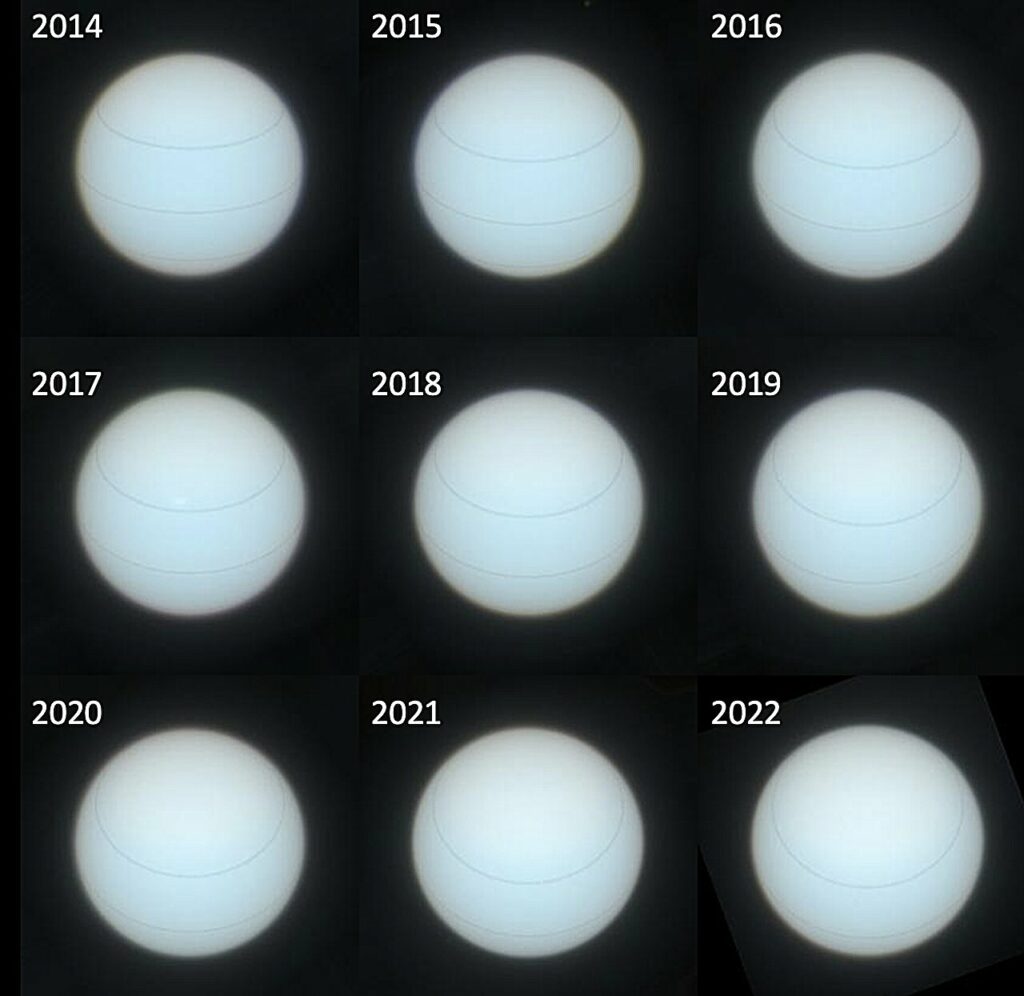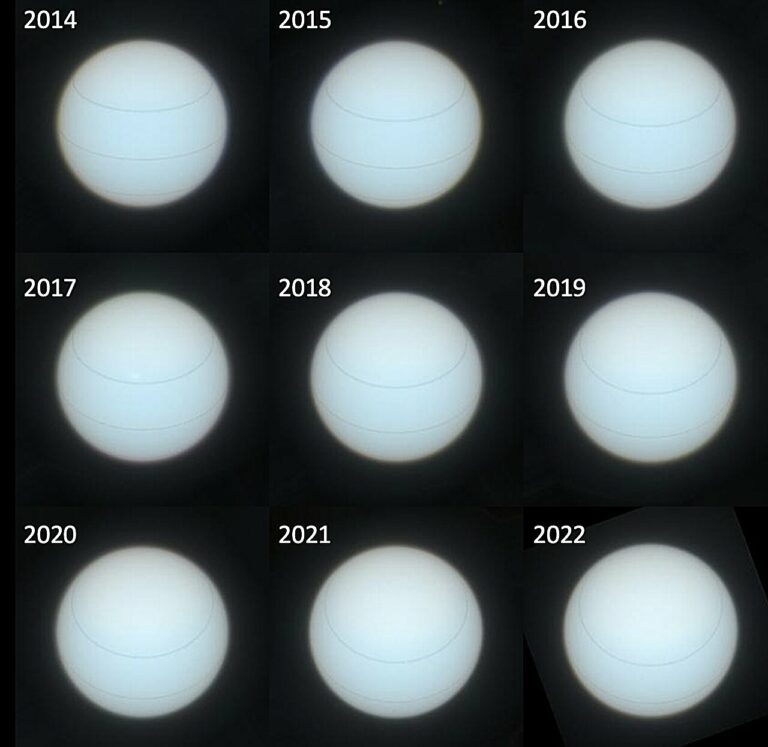Freshly Captured Images Unveil the True Appearances of Neptune and Uranus
Neptune is renowned for its distinctive rich blue hue, while Uranus is often associated with a greenish tint. However, a recent study led by Professor Patrick Irwin from the University of Oxford challenges the conventional perception, revealing that the true colors of these ice giants are remarkably similar.
Published in the Monthly Notices of the Royal Astronomical Society, the research confirms the accurate shades of the planets. Contrary to popular belief—where Neptune is perceived as a deep azure and Uranus as having a pale cyan appearance—both worlds exhibit a comparable shade of greenish-blue. Astronomers have been aware that most modern images of Neptune and Uranus do not faithfully represent their true colors.
This misconception arose due to images captured during the 20th century, including those from NASA’s Voyager 2 mission, the sole spacecraft to pass by these planets. The images were recorded in separate colors and later combined to create composite color images. However, these composites were not always accurately balanced to achieve a genuine representation of color, leading to the belief that Neptune was “too blue” and Uranus had a different hue. Professor Irwin explained,
“Even though the artificially-saturated color was known at the time among planetary scientists—and the images were released with captions explaining it—that distinction had become lost over time. Applying our model to the original data, we have been able to reconstitute the most accurate representation yet of the color of both Neptune and Uranus.”

In the recent study, the scientists utilized data from the Hubble Space Telescope’s Space Telescope Imaging Spectrograph (STIS) and the Multi Unit Spectroscopic Explorer (MUSE) on the European Southern Observatory’s Very Large Telescope. Notably, in both instruments, every pixel represents a continuous spectrum of colors. This characteristic allows the unambiguous processing of STIS and MUSE observations to ascertain the genuine apparent color of Uranus and Neptune.
Leveraging this data, the researchers recalibrated the composite color images captured by the Voyager 2 camera and the Hubble Space Telescope’s Wide Field Camera 3 (WFC3). The outcome revealed that Uranus and Neptune exhibit a relatively similar shade of greenish-blue, with a slight variance attributed to Neptune possessing a subtle additional blue tint, a feature unveiled by the model and linked to a thinner haze layer on that planet. Moreover, the study unravels the enduring mystery surrounding the slight color fluctuations of Uranus during its 84-year orbit around the sun.
The authors arrived at their conclusion by comparing images of the ice giant with brightness measurements recorded by the Lowell Observatory in Arizona from 1950–2016 at blue and green wavelengths. These measurements disclosed that Uranus appears slightly greener during its solstices (summer and winter) when one of its poles points towards the sun. In contrast, during its equinoxes—when the sun aligns with the equator—it exhibits a somewhat bluer tint. The unique spin of Uranus, almost on its side during its orbit, contributes to this phenomenon, as either pole nearly directly faces the sun and Earth during solstices.
The researchers developed a model comparing the spectra of Uranus’s polar and equatorial regions to understand the differences in reflectivity. The model revealed that the polar regions are more reflective at green and red wavelengths than at blue wavelengths, partly due to the lower abundance of methane, which absorbs red light, near the poles compared to the equator.
Nevertheless, this explanation did not suffice to fully account for the color change. Therefore, the researchers introduced a new factor into the model, resembling a “hood” of gradually thickening icy haze observed over the summer sunlit pole as the planet transitions from equinox to solstice. Astronomers believe this haze is likely composed of methane ice particles.
When incorporated into the model, these ice particles further heightened reflection at green and red wavelengths at the poles, providing an explanation for Uranus appearing greener at the solstice. Professor Irwin commented, “This is the first study to match a quantitative model to imaging data to explain why the color of Uranus changes during its orbit. In this way, we have demonstrated that Uranus is greener at the solstice due to the polar regions having reduced methane abundance but also an increased thickness of brightly scattering methane ice particles.” Dr. Heidi Hammel, of the Association of Universities for Research in Astronomy (AURA), who has extensively studied Neptune and Uranus but was not part of the study, remarked,
“The misperception of Neptune’s color, as well as the unusual color changes of Uranus, have bedeviled us for decades. This comprehensive study should finally put both issues to rest.” The ice giants Uranus and Neptune remain intriguing prospects for future robotic explorations, building upon the groundwork laid by Voyager in the 1980s. Professor Leigh Fletcher, a planetary scientist from the University of Leicester and co-author of the study, highlighted, “A mission to explore the Uranian system—from its peculiar seasonal atmosphere to its diverse array of rings and moons—is a high priority for space agencies in the decades to come.”
However, even a long-lasting planetary explorer in orbit around Uranus would capture only a brief snapshot of a Uranian year. Professor Fletcher emphasized the importance of Earth-based studies, like this one revealing changes in Uranus’s appearance and color over decades, in providing a broader context for future mission discoveries.
This article is republished from PhysORG under a Creative Commons license. Read the original article.
Do not forget to share your opinion with us to provide you with the best posts !




0 Comments